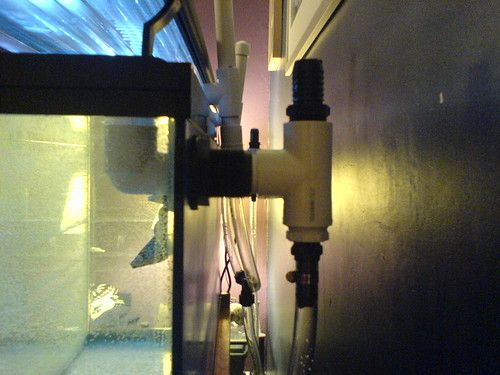eschaton
Fishaholic
Hey all, I posted on this some months ago, but now my girlfriend and I finally finished the stand (she had us buy it as a kit, and it took forever to put together, sand, and stain).
Anyway, right now I have, aside from the stand:
55 gallon tank, pre-drilled in two places, with the back sprayed
My light (Current Nova Extreme T-5 x 8)
The eventual sump tank (20-gallon high - has small chip in one corner, but still holds water fine).
Heater
I still need to buy a number of things, including the pump (don't know what to do here), an RO system, possibly a skimmer, etc.
But the actual setup is bewildering to me. I'm not very mechanically inclined. Here's what I can figure out for steps
1. In the tank I need to construct some sort of acrylic column things with weir teeth on the top. I know that there are bonding agents to weld acrylic to itself, but I don't know how I'm going to attach it to the glass. I also need to buy bulkheads, but I don't know which kind are best.
2. The plumbing. I think I want to use flexline as it seems more forgiving (I'm not very methodical and am worried about measuring 1/16th off for some pipe or another. I think just some lines straight down ought to cover it, but people mention these things called check valves and ball valves, and I don't know how useful/important they are. I have no idea what you use to weld pipes together either - silicone?
3. The sump itself. To keep it easy, I think I just want to have two baffles. I'll get the glass cut somewhere and silicone them in, but I'm not sure how you get the glass to stand upright inside the tank while the silicone is drying - and I'm really not sure how you suspend the second baffle. The main chamber will just be open and used for macroalgae - I'd rather use that for nutrient absorption than a skimmer. I'll just put the pump in the water and not drill the sump myself to make it easier.
I find it shocking while I can find a ton of stuff online about individual fish, there is almost nothing about aquarium plumbing except really generic diagrams that don't explain the tools you need. Any detailed help will be much appreciated, as I'm feeling really overwhelmed thinking of the complexity of all this.
Anyway, right now I have, aside from the stand:
55 gallon tank, pre-drilled in two places, with the back sprayed
My light (Current Nova Extreme T-5 x 8)
The eventual sump tank (20-gallon high - has small chip in one corner, but still holds water fine).
Heater
I still need to buy a number of things, including the pump (don't know what to do here), an RO system, possibly a skimmer, etc.
But the actual setup is bewildering to me. I'm not very mechanically inclined. Here's what I can figure out for steps
1. In the tank I need to construct some sort of acrylic column things with weir teeth on the top. I know that there are bonding agents to weld acrylic to itself, but I don't know how I'm going to attach it to the glass. I also need to buy bulkheads, but I don't know which kind are best.
2. The plumbing. I think I want to use flexline as it seems more forgiving (I'm not very methodical and am worried about measuring 1/16th off for some pipe or another. I think just some lines straight down ought to cover it, but people mention these things called check valves and ball valves, and I don't know how useful/important they are. I have no idea what you use to weld pipes together either - silicone?
3. The sump itself. To keep it easy, I think I just want to have two baffles. I'll get the glass cut somewhere and silicone them in, but I'm not sure how you get the glass to stand upright inside the tank while the silicone is drying - and I'm really not sure how you suspend the second baffle. The main chamber will just be open and used for macroalgae - I'd rather use that for nutrient absorption than a skimmer. I'll just put the pump in the water and not drill the sump myself to make it easier.
I find it shocking while I can find a ton of stuff online about individual fish, there is almost nothing about aquarium plumbing except really generic diagrams that don't explain the tools you need. Any detailed help will be much appreciated, as I'm feeling really overwhelmed thinking of the complexity of all this.

 /www.fishfurfeather.com/rigid-pipe-a...20_121_127.html
/www.fishfurfeather.com/rigid-pipe-a...20_121_127.html